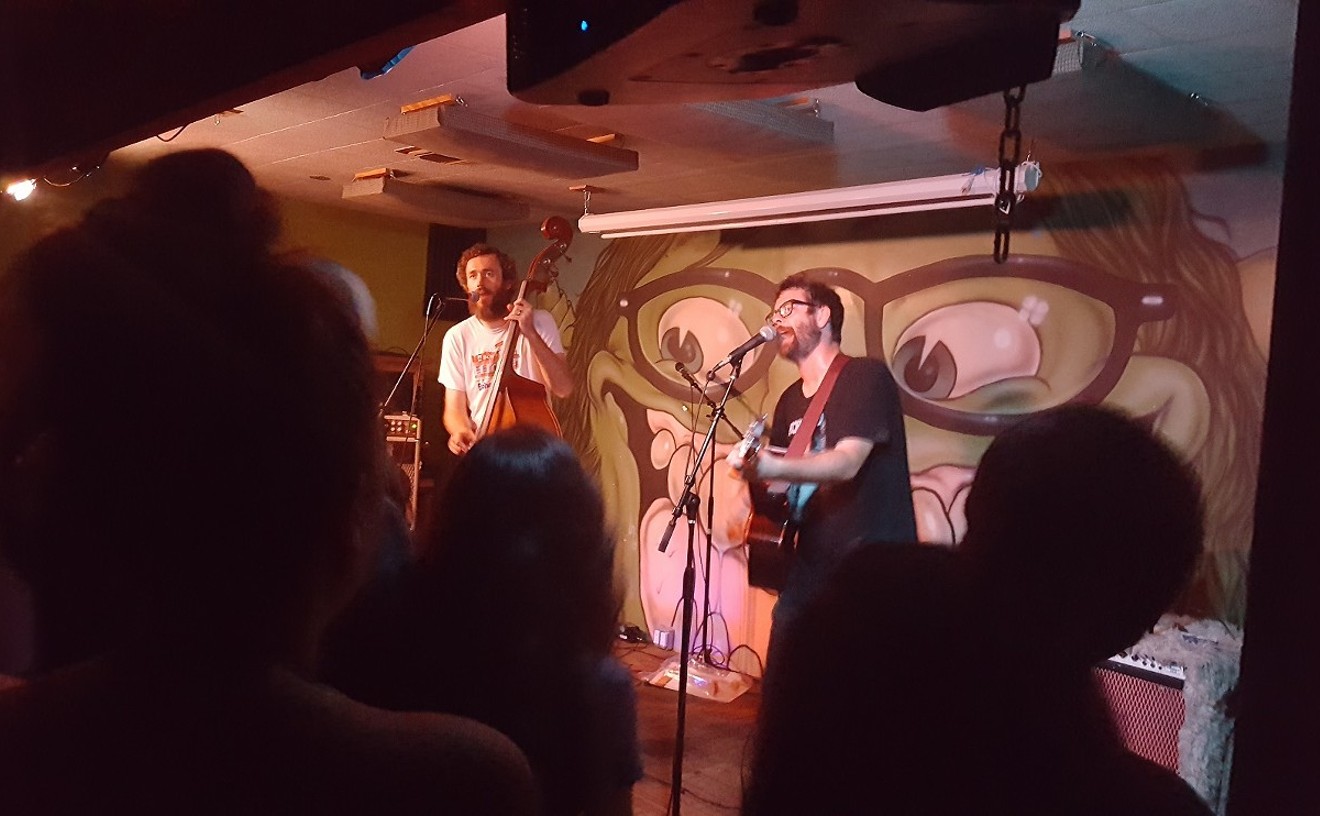Make no mistake — you'll need a detailed psychological road map to negotiate the twisted terrain appearing in paintings by Sue Chenoweth on display in "Sue Chenoweth: Real and Applied" at Modified Arts in downtown Phoenix. And chances are you're going to get seriously lost even before you ever reach base camp.
Just think of the journey as a scavenger hunt, where mysterious clues are given to one's next secret location. Eventually, in the delicious chaos you'll begin to see a strange but undeniable logic to the mystical but emotionally charged images on display.
Despite the description of the show appearing on Modified's website, "Real and Applied" actually is an amalgam of two distinct bodies of work Chenoweth created for two entirely different exhibitions held after her one-woman show, "Spyhopping," ran at Scottsdale Museum of Contemporary Art in 2010. The three 80-inch-by-80-inch mixed-media paintings on paper you'll see in Modified's show were made for the Pennsylvania Academy of the Fine Arts' group exhibition, "here.," mounted in Philadelphia from October through December 2011. That show, organized by multiple national curators, centered around the visions of 24 emerging artists from areas outside the usual American art centers of New York, Chicago, and Los Angeles. The artists' challenge was to explore the meaning and effect of "home" and "place" on their art in a world of inevitable cultural globalization.
The remaining smaller works on paper interspersed throughout "Real and Applied" were created here in Phoenix before Chenoweth began an idyllic five-week residency at Largo das Artes, Brazil, away from the typical tourist attractions of Rio de Janeiro. The residency was underwritten with funds raised by Phoenix Institute of Contemporary Art, a nonprofit cultural organization started by Ted Decker, Greg Esser, and Eddie Shea to promote the work of local artists.
These pieces appeared in an exhibition staged at Largo's exhibition gallery in Rio and amount to Chenoweth's fanciful, non-linear ideas of Brazil, based on extensive research done before her actually experiencing it. Basically, this work represents what the artist dreamily imagined this exotic destination would be like. Only one piece in the show, Do I Have Anything to Do with These Ghost Trees? (2012), featuring slashed rubber trees, was created during Chenoweth's Brazilian sojourn.
Though spurred by differing thematic concerns, the admixture of the two separate exhibitions does nothing to dilute the power of either group of work, since both deal with what is concretely real and what is purely illusory. It also ends up being a perfect balance between the sacred and the profane.
According to the artist, the works from PAFA's Philly show have more to do with Chenoweth's mental "here" than any physical place. And her "here" is all over the map, both literally and figuratively. These pieces were initially spurred on by the allegory of Plato's Cave, an ancient philosophical discussion about the nature of idea and reality that continues to drive first-year philosophy students completely mad on a regular basis. In a nutshell, the allegory deals with what we perceive to be real, which, according to Plato, consists of mere reflections or shadows of reality, and reality itself, which he believed to be the truth or essence behind what we are perceiving.
Popping up in all four "here." images is a mountainous peak that the artist says she patterned after Mount Everest, together with meandering pathways, all ultimately leading to the mountain's pinnacle, an obvious reference to attaining the highest stage of spiritual development to which man can aspire. This is underscored by the appearance of triangles Chenoweth says are Tibetan prayer flags. Or not. Triangular shapes have haunted the artist's older work in the form of sharks' teeth and arrows leading to grisly human remains left by marauding grizzly bears, so it's hard to tell. (Full disclosure: The reviewer wrote the catalog essay for Chenoweth's 2009 show, "Predator and Prey.")
Adding to the insanity are the artist's other disparate inspirations. In To Climb the Highest Peak (2011), a neon-tongued fire appears at the bottom of the image; from the smoke arise flowers Chenoweth patterned after ones on a Chinese cloisonné vase owned by her father. The flowers seem to flutter around a stalactite-encrusted cave on the way up the mountain, evoking the description of Shangri-La, a fictional, isolated Tibetan utopia hidden away in the Himalayas, where all is peaceful and humans pretty much never die.
In counterpoint, tiny orange tents cluster at the base of the mountain, reminders of the treacherous, death-defying climb ahead, reappearing more prominently in Wouldn't He Remember His First Home? What Passed for Wisdom There? (2011). In this piece, the artist has painted a "you are here" dot from which blue paths, some lined with prayer flags, emanate then encircle another cave. They eventually surround Chenoweth's recurrent mountain peak, this one shrouded in clouds. Flowers float upward like butterflies and black vinyl wall decals resembling delicate ferns nestle in pockets created by the painting's circuitous tracks.
Just to keep viewers on their toes, in Pulled Out in an Iron Bucket (2011), Chenoweth has painted what looks like a round-bottom cauldron from which stream those same fern shapes bobbing on a sea of transparent waves and foil-outlined floral shapes. The cauldron is actually an iron bucket the artist's grandparents rode in at New Mexico's Carlsbad Cavern in the early 1920s. Tourists, apparently less picky then about safety, were loaded into what actually was a bucket used to haul bat guano out of the cave by hand and lowered into the darkness for a peek at the cave's stunning subterranean landscape.
As for Chenoweth's preconceived notions about Brazil, the artist freely admits she knew nothing about the place before she went except for what she had unearthed during her research of the place. "These [paintings in "Real and Applied"] are what I imagined Brazil to be like," she says. "I had no idea. I imagined it as a hot sexpot place with volcanoes and jungle and favelas." The whole erupting volcano concept sprung from a friend's tale of a bursting boil on her arm: "Where's a volcano in Brazil? They don't have any, except for one extinct volcano in an archipelago near Trindade."
Never one to be stopped by mere facts, the artist includes volcanic imagery in several paintings, including Trinity Island (Ilha de Trindade), Brazil (2012) and Southern Cross (2012). Ignore the fact that the volcano in the latter work actually is Italy's Vesuvius, though it turns out that the Southern Cross, a stellar configuration visible only in the southern hemisphere, actually appears on the Brazilian flag.
Sex and favelas also figure prominently in the pre-Brazil work. Look closely and you can make out tiny people engaged in deconstructed orgies in below-ground pockets and veins — and those clusters of minute squares strewn liberally throughout the pieces are the artist's rendering of Brazil's notorious hillside slums. "Brazil is sexual, gorgeous; they celebrate sexuality and their bodies. Even people in their 70s have bikinis on and nobody cares," Chenoweth notes. "I looked up as many sexual positions as I could during my research. One's called 'ride 'em pony.'"
Given Sue Chenoweth's pre-visit imagery, we are almost afraid to predict what her post-visit work might involve. Stay tuned.










